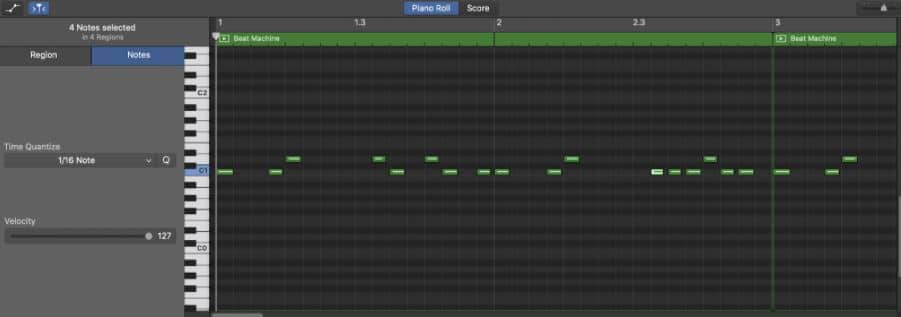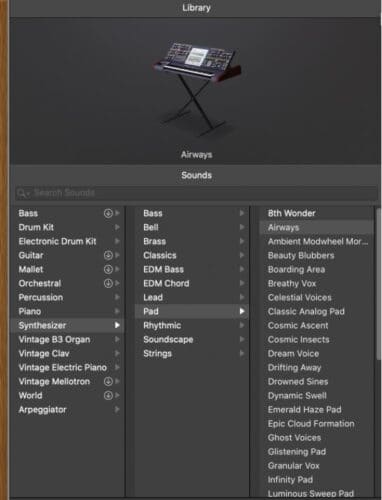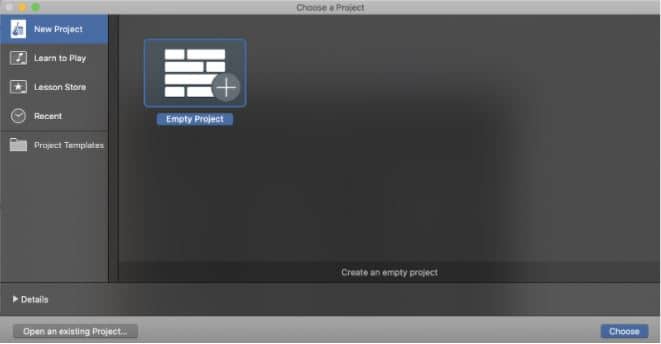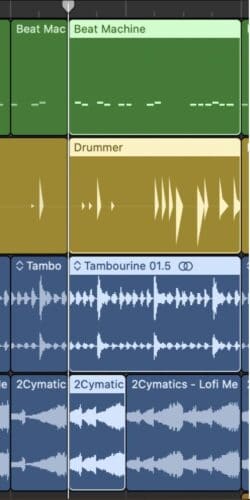There are a lot of GarageBand shortcuts to master. Some more useful than others to your day to day business and for speeding up your workflows. Those are the ones you’re going to learn about right here:
21 GarageBand shortcuts that will have you whizzing through your projects like a pro.
Let’s dive in.
Fast GarageBand Shortcuts
Many shortcuts in GarageBand require just one keystroke, they’re super fast.
Let’s take a look:
Start recording – R
Simply hit the R key, and whatever tracks you have record-armed will start tracking.
Turn Cycle on or off – C
The Cycle is the little yellow bar at the top of your screen, which you can click and drag to select different areas of your arrangement.
Turning the Cycle on means that GarageBand will continuously loop your selection. Hit C again to turn it off again and play through the rest of your track.
Open automation lanes – A
GarageBand’s automation lanes are visualized as a separate layer in the arrange window. Hit the A key to open them up, and then pick which one you want to work on in the track header.

Hit A again to switch back to the standard view.
Open smart controls – B
Hitting B opens up the smart controls pane at the bottom of your screen, allowing you to add plugins to your track, manipulate EQ and compression settings, and set track inputs.
Open loop browser – O
A major benefit of this free software from Apple is the access to a huge library of Apple Loops.
Hit O to open up the loop browser on the right-hand side of your screen, and get creative!
Open piano roll – P
The piano roll is where you can key in MIDI data for software instruments, or edit MIDI data that you’re already working with.

Quantize select events – Q
When you’re working with MIDI data, especially data that you’ve tapped in yourself using a keyboard, you might find it doesn’t align to the beat.
With your data selected, simply hit the Q key to quantize it, which will automatically snap each of the MIDI notes to its nearest grid increment.
Loop region continuously – L
If you’ve got a little piece of audio you want to loop for the rest of the track, click it, and hit the L key.
The region will then loop continuously. You can then click and drag in from the right-hand corner to decrease the loop length.
Solo selected track – S
Want to hear a single track in isolation? Just hit S to solo it.
Mute selected track – M
Looking to hear what your arrangement sounds like when you drop out of the hihats? Hit the M button with the track selected.
Open instrument library – Y
GarageBand’s huge range of software instruments is a massive win for producers and podcasters alike.
To browse all of GarageBand’s instruments, just hit the Y key to bring up the library on the left-hand side of your screen.

Start or stop playback – Space Bar
To play your track (or to stop playback), just use the space bar. Easy.
Move playhead back one bar – Comma/Period (, / .)
There are a few different things you can do with GarageBand with the playhead set (more on that later). Use the comma and period keys to move the playhead back or forward by one bar.
Select track above/below – Up/Down Arrow
You can quickly and easily switch between tracks in the arrange window using the up and down arrows.
Best Garage Band Multi-Key Shortcuts
Adding Apple’s famous Command key into the mix opens up a whole new world of possibilities when it comes to GarageBand shortcuts.
New project – Command N
Bored of what you’re working on and ready to start a new project?
Hit Command N to quit the session you have open and open up a new one.

Musical typing keyboard – Command R
If you don’t have a MIDI keyboard connected, you can still punch in melodies without having to rely on the old mouse.
Hit Command R to bring up the musical typing keyboard, which turns your computer keyboard into a musical one!
Duplicate track – Command D
Love the settings you’ve got on one track, and want to add a second track with the exact same stuff?
Hit Command D to duplicate it.
Split regions at playboard – Command T
When you’re editing a podcast or beat, sometimes you’ll need to cut an audio or MIDI region at a very precise place.
To do this, position your playhead, and hit Command T to split the regions you have selected.

Open a project – Command O
Suddenly inspired to work on a beat you started a few weeks ago?
Hit Command O to open it up.
Save project – Command S
Don’t forget to save your project as you go!
Command S is your best friend.
New track – Option Command N
This ones a three-key command and can be used to quickly create a new track below the one you currently have selected.
Conclusion
Now that you’ve got the keys to success, as it were, there’s just one thing left to do:
Remember to actually use them!
It can be easy to fall back into the trap of using your mouse for everything, especially if you’re already used to that.
Commit to embedding the new habit, and you’ll be working way faster in a matter of days.
